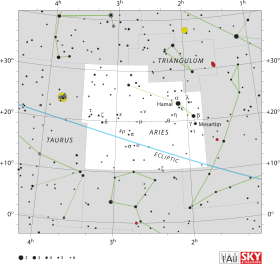Eta Arietis ou η Arietis , est une étoile de la constellation du Bélier . Elle est faiblement visible à l'œil nu avec une magnitude apparente de 5,231[ 2] mas [ 1] a.l. pc vitesse radiale de +4,5 km/s[ 2]
Il s'agit d'une étoile jaune-blanc de la séquence principale avec un type spectral F5V[ 3] Soleil , avec un âge d'environ 2,6 milliards d'années [ 2] température effective de l'atmosphère extérieure est de 6 380 K [ 3] High Accuracy Radial velocity Planet Searcher orbite , mais aucun signal n'a été détecté[ 8] excès d'infrarouge n'a été détecté à l'aide du télescope spatial Spitzer gaz ou de poussière circumstellaire [ 9]
↑ a b c d e et f
(en) A. G. A. Brown et al. Gaia collaboration), « Gaia Data Release 2 : Summary of the contents and survey propertiesAstronomy & Astrophysics vol. 616, août 2018 , article no A1 (DOI 10.1051/0004-6361/201833051 Bibcode 2018A&A...616A...1G arXiv 1804.09365
↑ a b c d e f et g (en) J. Holmberg, B. Nordström et J. Andersen, « The Geneva-Copenhagen survey of the solar neighbourhood. III. Improved distances, ages, and kinematics Astronomy & Astrophysics vol. 501, no 3, juillet 2009 , p. 941–947 (DOI 10.1051/0004-6361/200811191 Bibcode 2009A&A...501..941H arXiv 0811.3982 S2CID 118577511 ↑ a b c d et e (en) A. J. Cenarro et al. Medium-resolution Isaac Newton Telescope library of empirical spectra - II. The stellar atmospheric parameters Monthly Notices of the Royal Astronomical Society vol. 374, no 2, janvier 2007 , p. 664–690 (DOI 10.1111/j.1365-2966.2006.11196.x Bibcode 2007MNRAS.374..664C arXiv astro-ph/0611618 S2CID 119428437 ↑ a b et c (en) eta Ari sur la base de données Simbad Centre de données astronomiques de Strasbourg .↑ a et b (en) R. Earle Luck, « Abundances in the Local Region II: F, G, and K Dwarfs and Subgiants The Astronomical Journal vol. 153, no 1, janvier 2017 , p. 19 (DOI 10.3847/1538-3881/153/1/21 Bibcode 2017AJ....153...21L arXiv 1611.02897 S2CID 119511744 ↑ a b et c (en) Mathew Schofield, William J. Chaplin, Daniel Huber, Tiago L. Campante, Guy R. Davies, Andrea Miglio, Warrick H. Ball, Thierry Appourchaux, Sarbani Basu, Timothy R. Bedding, Jørgen Christensen-Dalsgaard, Orlagh Creevey, Rafael A. García, Rasmus Handberg et Steven D. Kawaler, « The Asteroseismic Target List for Solar-like Oscillators Observed in 2 minute Cadence with the Transiting Exoplanet Survey Satellite The Astronomical Journal Supplement Series vol. 241, no 1, 1er mars 2019p. 12 (ISSN 0067-0049 DOI 10.3847/1538-4365/ab04f5 Bibcode 2019ApJS..241...12S arXiv 1901.10148 ↑ (en) Yoichi Takeda et al. High-Dispersion Spectra Collection of Nearby F--K Stars at Okayama Astrophysical Observatory: A Basis for Spectroscopic Abundance Standards Publications of the Astronomical Society of Japan vol. 57, no 1, février 2005 , p. 13–25 (DOI 10.1093/pasj/57.1.13 Bibcode 2005PASJ...57...13T ↑ (en) A.-M. Lagrange et al. Extrasolar planets and brown dwarfs around A-F type stars. VI. High precision RV survey of early type dwarfs with HARPS Astronomy & Astrophysics vol. 495, no 1, février 2009 , p. 335–352 (DOI 10.1051/0004-6361:200810105 Bibcode 2009A&A...495..335L arXiv 0809.4636 S2CID 62894956 ↑ (en) D. E. Trilling et al. Debris Disks around Sun-like Stars The Astronomical Journal vol. 674, no 2, février 2008 , p. 1086–1105 (DOI 10.1086/525514 Bibcode 2008ApJ...674.1086T arXiv 0710.5498 S2CID 54940779
Liens externes
Ressource relative à l'astronomie :
